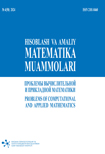Employing various machine learning algorithms to predict mortality after acute myocardial infarction using GUSTO-1 medical data
Keywords:
ml, logistic regression, decision trees, random forest, GUSTO-I, myocardial infarction, cross-validationAbstract
Now in the world there are a lot of diseases threatening humanity and for these medical treatments and diagnostic methods have also improved both in practical and statistical. This paper discusses one of the most leading diseases, myocardial infarction. The mortality results showed that 18.8% of the patients hospitalized with MI diagnosis had died. Gender results revealed that around 28% of the deceased MI patients were women and 14% of them were men. So, by these statistics there are vital needs emerg ing in the diagnostician and prediction for making disease prevention and mitigation plans. To do that, one of cutting-edge methods is classical Ml prediction algorithms. The experiments and results showed that GUSTO-I trial data was used to train models in different kinds of ML algorithms, in terms of accuracy, the Random Forest algorithm showed slightly better results. And, to evaluate the model different methods are used including cross-validation and metrics are precision, Recall (Sensitivity), F1 Score, Con fusion Matrix but the final accuracy metric was Confusion Matrix. In the end, to predict long term mortality from myocardial infarction, a machine learning model trained and analyzed that for the GUSTO-I cardio data, the slightly effective algorithm is random forest.
References
Rohani C, Jafarpoor H, Mortazavi Y, Esbakian B, Gholinia H. 2022. Mortality in patients with myocardial infarction and potential risk factors: A five-year data analysis. ARYA Atheroscler. May;18(3):– P. 1-8. doi: 10.48305/arya.v18i0.2427. PMID: 36815954; PM CID: PMC9931944.
Califf RM, White HD, Van de Werf F, Sadowski Z, Armstrong PW, Vahanian A, Simoons ML, Simes RJ, Lee KL, Topol EJ. 1996. One-year results from the Global Utilization of Streptokinase and TPA for Occluded Coronary Arteries (GUSTO-I) trial. GUSTO-I Investigators. Circulation. Sep 15;94(6):1233-8. doi: 10.1161/01.cir.94.6.1233. PMID: 8822974.
Bijan Roodini, Boshra Khajehpiri, Hamid Abrishami Moghaddam, Mohamad Forouzanfar 2024. Machine learning predicts long-term mortality after acute myocardial infarction using systolic time intervals and routinely collected clinical data, Intelligent Medicine, ISSN 2667 1026, https://doi.org/10.1016/j.imed.2024.01.001.
Mandeep Singh, Jennifer White, David Hasdai, Patricia K. Hodgson, Peter B. Berger, Eric J. Topol, Robert M. Califf, David R. Holmes 2007. Long-Term Outcome and its Predictors Among Patients With ST-Segment Elevation Myocardial Infarction Complicated by Shock: Insights From the GUSTO-I Trial, Journal of the American College of Cardiology, Volume 50, Issue 18,– P. 1752-1758. ISSN 0735-1097, https://doi.org/10.1016/j.jacc.2007.04.101.
2023. An International Randomized Trial Comparing Four Thrombolytic Strategies for Acute Myocardial Infarction // 10.1056/NEJM199309023291001,New England Journal of Medicine
2019. Clinical Prediction Models, A Practical Approach to Development, Validation, and Updating, Ewout W. Steyerberg,https://doi.org/10.1007/978-3-030-16399-0,978-3-030 16398-3, Published: 01 August
Yu. Kononova, L. Abramyan, A. Funkner, A. Babenko 2024. Machine learning pre diction of in-hospital recurrent infarction and cardiac death in patients with myocar dial infarction, Informatics in Medicine Unlocked, Volume 45, 101443, ISSN 2352-9148, https://doi.org/10.1016/j.imu.2023.101443.
Alnuaimi, Amer Albaldawi, Tasnim. 2024. An overview of machine learning classification techniques. BIO Web of Conferences. 97. 00133. 10.1051/bioconf/20249700133.
Pijush Dutta, Shobhandeb Paul, Asok Kumar 2021. Chapter 25- Comparative analy sis of various supervised machine learning techniques for diagnosis of COVID-19,Editor(s): Suman Lata Tripathi, Valentina E. Balas, S.K. Mohapatra, Kolla Bhanu Prakash, Jan menjoy Nayak,Electronic Devices, Circuits, and Systems for Biomedical Applications, Academic Press,– P. 521–540. ISBN 9780323851725,https://doi.org/10.1016/B978-0-323 85172-5.00020-4.
Robert Nisbet, Gary Miner, Ken Yale 2018. Chapter 9- Classification,Editor(s): Robert Nisbet, Gary Miner, Ken Yale,Handbook of Statistical Analysis and Data Mining Ap plications (Second Edition), Academic Press,– P. 169–186. ISBN 9780124166325, https://doi.org/10.1016/B978-0-12-416632-5.00009-8.
Abdulhamit Subasi 2020. Chapter 11- Use of artificial intelligence in Alzheimer’s disease de tection,Editor(s): Debmalya Barh,ArtificialIntelligence in Precision Health,Academic Press,– P. 257–278,ISBN 9780128171332,https://doi.org/10.1016/B978-0-12-817133-2.00011-2.
Uduak A. Umoh, Imo J. Eyoh, Vadivel S. Murugesan, Emmanuel E. Nyoho 2022. Chap ter 14- Fuzzy-machine learning models for the prediction of fire outbreaks: A compar ative analysis,Editor(s): Rajiv Pandey, Sunil Kumar Khatri, Neerajkumar Singh, Parul Verma,Artificial Intelligence and Machine Learning for EDGE Computing,Academic Press,– P. 207-233,ISBN 9780128240540,https://doi.org/10.1016/B978-0-12-824054-0.00025-3.
Modhugu V.R., Ponnusamy S. 2024. Comparative Analysis of Machine Learning Algorithms for Liver Disease Prediction: SVM, Logistic Regression, and Decision Tree. Asian Journal of Research in Computer Science, 17(6),– P. 188–201.
Balboa A., Cuesta A., González-Villa J., Ortiz G., Alvear D. 2024. Logistic regression vs machine learning to predict evacuation decisions in fire alarm situations. Safety science, 174, 106485.
Shin TG, Lee Y, Kim K, Lee MS, Kwon JM 2023. ROMIAE study group. ROMIAE (Rule Out Acute Myocardial Infarction Using Artificial Intelligence Electrocardiogram Analysis) trial study protocol: a prospective multicenter observational study for validation of a deep learning-based 12-lead electrocardiogram analysis model for detecting acute myocar dial infarction in patients visiting the emergency department. Clin Exp Emerg Med. 2023 Dec;10(4): 438-445. doi: 10.15441/ceem.22.360. Epub Nov 28. PMID: 38012820; PMCID: PMC10790062.
Siddiqui, H.U.R., Zafar, K., Saleem, A.A. et al. 2024. Artificial intelligence-based myocar dial infarction diagnosis: a comprehensive review of modern techniques. Multimed Tools Appl 83, 41951–41979 https://doi.org/10.1007/s11042-023-17246-0
Minwook Kim, Donggil Kang, Min Sun Kim, Jeong Cheon Choe, Sun-Hack Lee, Jin Hee Ahn, Jun-Hyok Oh, Jung Hyun Choi, Han Cheol Lee, Kwang Soo Cha, Kyungtae Jang, WooR I Bong, Giltae Song, Hyewon Lee 2024. Acute myocardial infarction prog nosis prediction with reliable and interpretable artificial intelligence system, Journal of the American Medical Informatics Association, Volume 31, Issue 7, July Pages 1540–1550, https://doi.org/10.1093/jamia/ocae114
Cho, Y., Kwon, Jm., Kim, KH. et al. 2020. Artificial intelligence algorithm for de tecting myocardial infarction using six-lead electrocardiography. Sci Rep 10, 20495 . https://doi.org/10.1038/s41598-020-77599-6
Rojek I., Kozielski M., Dorożyński J., Mikołajewski D. 2022. AI-Based Prediction of My ocardial Infarction Risk as an Element of Preventive Medicine. Appl. Sci. 12, 9596. https://doi.org/10.3390/app12199596
Ramirez E, Ruiperez S, Castells F, Millet J. 2024. Explainable AI for myocardial infarction using the vectorcardiogram.. Europace. May 24;26(Suppl 1):euae102.548. doi: 10.1093/eu ropace/euae102.548. PMCID: PMC11119432.
Melissa Pelly, Farhad Fatehi, Danny Liew, Antonio Verdejo-Garcia 2023 Artificial intelligence for secondary prevention of myocardial infarction: A qualitative study of patient and health professional perspectives,International Journal of Medical Informatics,Volume 173,2023,105041,ISSN 1386-5056,https://doi.org/10.1016/j.ijmedinf.2023.105041. (https://www.sciencedirect.com/science/article/pii/S138650562300059X)





